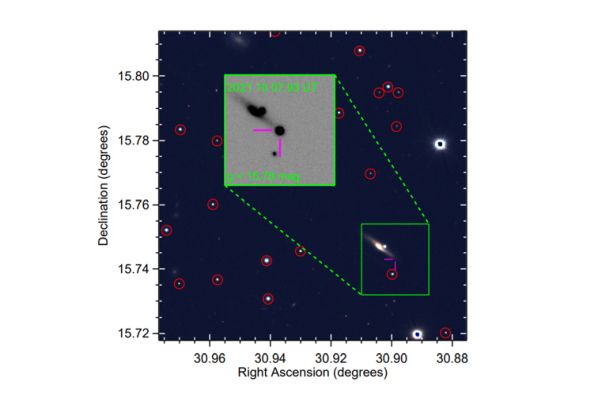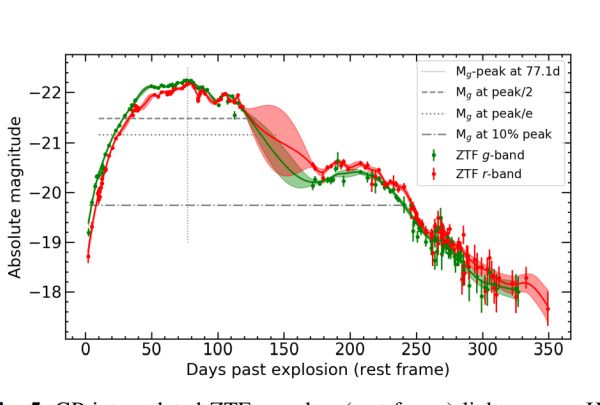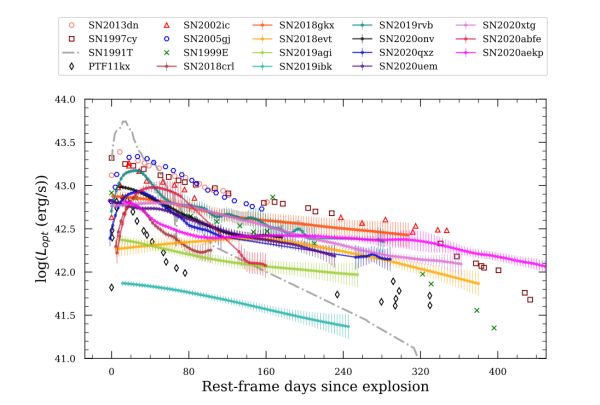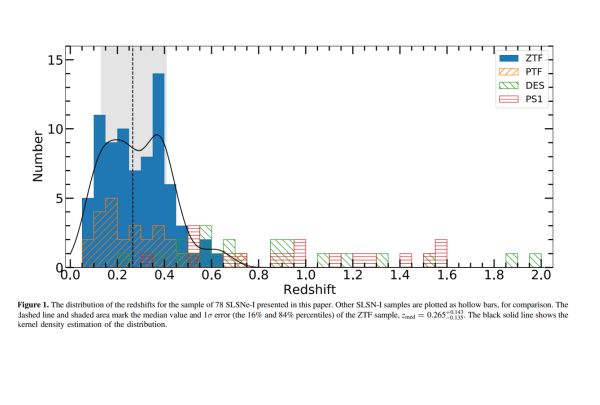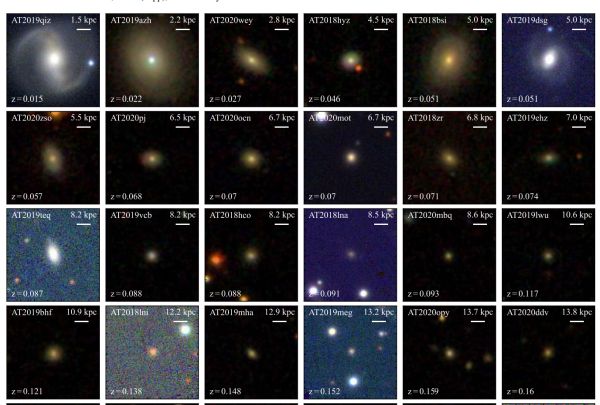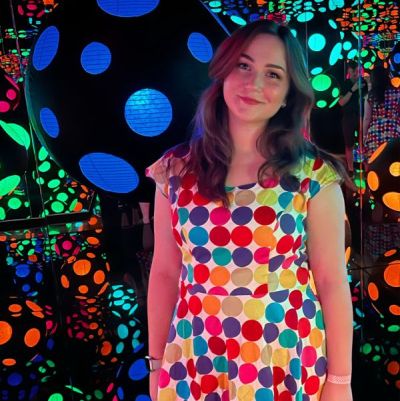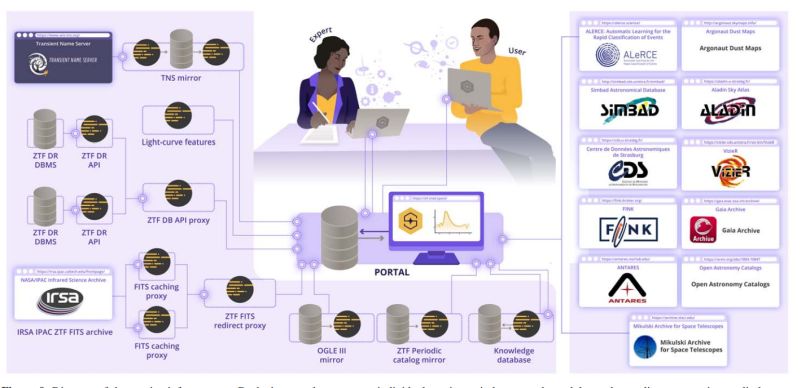ZTF Public Data Release 16
The Zwicky Transient Facility (ZTF) and IPAC at the California Institute of Technology announce the sixteenth ZTF Public Data Release. This release adds 2 months of observations to the fifteenth data release, up to 7 Jan 2023 for the public portion of the survey, and private survey time prior to 6 Sept 2021.
The products include 47.6 million single-exposure images, 172 thousand co-added images, accompanying source catalog files containing 746 billion source detections extracted from those images, and 4.64 billion light curves constructed from the single-exposure extractions.
Science Highlights
A candidate for a double white dwarf merger event
The ZTF team discovered an ultra-luminous and slowly evolving Type Ia supernova SN2021zny and launched a multi-wavelength observational campaign within 5.3 hours after the explosion (making SN 2021zny one of the earliest observed members of its class). The spectroscopic and photometric analysis revealed a progenitor system of two carbon/oxygen white dwarfs that undergo a merger event, with the disrupted white dwarf ejecting carbon-rich circumstellar material prior to the primary white dwarf detonation.
A rare hydrogen poor superluminous supernova
ZTF astronomers led by partners at Stockholm University have carried out a detailed analysis of SN 2020qlb (ZTF20abobpcb) - one of the brightest superluminous supernovae with the longest rise time (77 days from explosion to maximum). This paper discusses the potential power source of the collosal explosion and the physical origins of the observed light curve features.
Ia-CSM supernovae from the ZTF Bright Transient Survey
Sieving through the Bright Transient Survey, ZTF researchers have almost doubled the sample size of a rare subclass of type Ia supernovae known as SNe Ia-CSM. This class exhibits strong narrow hydrogen emission on top of a diluted over-luminous Type Ia spectrum. This study presents an analysis of the optical and mid-IR light curves, optical spectra, and host galaxy properties of this sample.
The largest sample of hydrogen-poor superluminous supernovae
In a series of two papers, astronomers present the largest sample from a single survey of 78 hydrogen-poor superluminous supernovae. The first paper presents the data , while the second one focuses on a more detailed analysis of the lightcurves. The photometric data comes primarily from the ZTF survey.
An analysis of the largest TDE sample from a single survey
The authors present a uniformly selected sample of 30 spectroscopically classified TDEs from the Zwicky Transient Facility Phase I survey operations with follow-up Swift UV and X-ray observations. This sample of optically selected TDEs is the largest sample of TDEs from a single survey yet.
ZTF Faces
Erica Hammerstein
(University of Maryland, USA)
I grew up in Canton, Michigan and spent a lot of time about 20 minutes away in Ann Arbor during high school. I first became interested in astronomy back in elementary school when we did a unit on the solar system in science class.
Read OnChang Liu
(Northwestern University, USA)
I was born in Xinchang, a mountainous, peaceful town in Southeast China. I used to wander along the creeks and bamboo forests as all those ancient Chinese poets did a thousand years ago. It was then when I was first fascinated by nature during star-counting and daydreaming, long before I started learning physics.
Read OnZTF Science Vlog
The ZTF vlog brings you the latest ZTF results presented by the authors themselves.
HAFFET - a new tool for model vs data comparison for large supernova datasets
Sheng Yang, a PhD student at the University of Stockholm, Sweden, presents a new Python-based software package that allows users to work with supernova datasets from any open survey and make a statistically consistent comparison between models and data. This tool will become increasingly important in the era of Vera Rubin LSST survey.
Are collapsars sites of heavy element production?
PhD student Shreya Anand (Caltech) describes a systematic study of a set of supernovae associated with collapsars - stars that have died due to gravitational collapse turning into a white dwarf, neutron star, or black hole. The lightcurve analysis shows no evidence that these types of stars can be a production site of heavy elements.
The challenges of discoverying and studying low activity comets
In this vlog, ZTF researcher Quanzhi Ye from the University of Maryland/Boston University presents the discovery and study of a very faint comet P/2021 HS that only exhibits a coma within a few weeks of its perihelion passage, which is atypical for a comet. This discovery highlights the challenges of detecting comets with extremely low activity levels.
Science with public ZTF data
We highlight scientific publications from individuals and groups outside of the ZTF partnership that use ZTF public data
The authors describe the SNAD Viewer, a web portal for astronomers which presents a centralized view of individual objects from the Zwicky Transient Facility's (ZTF) data releases, including data gathered from multiple publicly available astronomical archives and data sources. Initially built to enable efficient expert feedback in the context of adaptive machine learning applications, it has evolved into a full-fledged community asset that centralizes public information and provides a multi-dimensional view of ZTF sources.
'How-to' Guide
Deep referencing images
Caltech IPAC are publicly releasing additional "deep" reference images. These references were created to difference long-exposure ToO observations, They differ from the standard reference images in two ways: (1) they are created from up to 100 input images (compared to between 15-40 for standard refs) and (2) they are refreshed on a rolling 1-year schedule (compared to the fixed standard refs).
These "deep" images are now available, and searchable, via the IRSA IBE interface. Accompanying metadata are also available via the IRSA TAP service as well as the sqlite metadata file updated per data release. IRSA are working on access through the Image GUI.
ZTF API guide ZTF sqlite ExampleFeatured video
Classifying supernovae with ZTF
This short video shows all the publicly classified supernovae with the ZTF Bright Transient Survey. It covers the period up to 20 Feb 2023. The Bright Transient survey (BTS) is one of the key observing programs of ZTF and the largest supernova survey to date.
Outreach
Logo competition for the ZTF mobile app ZARTH
We continue to accept entries for the ZARTH logo competion. Anyone can join and earn 100 USD gift card from the Palomar Observatory gift shop.
ZARTH stands for ZTF Augmented Reality Transient Hunter and it is a mobile app game designed to reveal the dynamic and transient universe to the general public. Inspired by Pokemon Go, ZARTH players can use their phones to "catch" various types of real transient candidates extracted from the ZTF survey daily and projected onto a sky map. Players earn points for each transient they catch and they can also trade some of these back in a fashion similar to a stock market. In the process, players will learn what type of transient events exist, how frequent they are and what makes some of them more valuable to astronomers.
ZARTH website
ZTF is supported by the National Science Foundation and a collaboration including Caltech, IPAC, the
Weizmann Institute for Science, the Oskar Klein Center at Stockholm University, the University of
Maryland, Deutsches Elektronen-Synchrotron and Humboldt University, Lawrence Livermore National
Laboratory, the TANGO Consortium of Taiwan, the University of Wisconsin at Milwaukee, Trinity College
Dublin, IN2P3, University of Warwick, Ruhr University Bochum, and Northwestern University . Operations are conducted
by COO, IPAC and University of Washington.
Any opinions, findings, and conclusions or recommendations expressed in this material are those of the
author(s) and do not necessarily reflect the views of the National Science Foundation.
